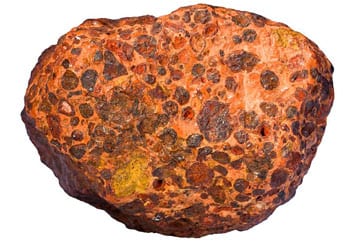Yan Language:
Aluminiomu ni wọpọ irin ano ri lori Earth, totaling about 8% ti awọn Earth ká erunrun. sibẹsibẹ, aluminum as an element is reactive and therefore does not occur naturally – it needs to be refined to produce aluminum metal. Awọn jc starting ohun elo fun aluminiomu refining ni bauxite, ni agbaye ni akọkọ ti owo orisun ti aluminiomu. Bauxite is a sedimentary rock, and consists mostly of the aluminium minerals gibbsite (Al(OH)3), boehmite (c-Ålö(OH)) ati diaspore (a-Ålö(OH)), and is usually mixed with the two iron oxides goethite and hematite, the aluminium clay mineral kaolinite and small amounts of anatase (TiO2) and/or ilmenite (FeTiO3).

Bauxite idogo ti wa ni tan ni agbaye, okeene sẹlẹ ni ni Tropical tabi subtropical awọn ẹkun ni. Although proven reserves of bauxite are expected to last for many years, awọn didara ti awọn ẹtọ ti o le wa aje wọle wa ni declining. fun refiners, who are in the business of bauxite processing to make alumina, ati ki o bajẹ aluminiomu irin, yi ni a ipenija pẹlu mejeeji owo ati ayika lojo.
The process to refine metallurgical bauxite into alumina involves the following inputs:
The following outputs are generated:

The most widely used chemical process of refining bauxite into alumina, ilana Bayer, involves dissolving the Al2O3 out of the bauxite rock with caustic soda (NaOH) at elevated temperature and pressure. The Al2O3 fraction of the bauxite is dissolved into solution, to later be precipitated out as alumina. sibẹsibẹ, a high-grade bauxite contains up to 60% Al2O3, and many operating bauxite deposits are well below this, lẹẹkọọkan bi kekere bi 30-40% Al2O3. Because the desired product is a high purity Al2O3, awọn ti o ku oxides ni bauxite (Fe2O3, SiO2, TiO2, Organic material) are separated from the Al2O3 and rejected as alumina refinery resides (ARR) or red mud. Ni Gbogbogbo, isalẹ didara awọn bauxite (ie lower Al2O3 content) the more red mud is generated per ton of alumina product. Ni afikun, even some Al2O3 bearing minerals, paapa kaolinite, produce un-desirable side reactions during the refining process and lead to an increase in red mud generation, bi daradara bi a isonu ti gbowolori caustic omi onisuga kemikali, kan ti o tobi ayípadà iye owo ni awọn bauxite refining ilana.
Red pẹtẹpẹtẹ tabi ARR o duro kan ti o tobi ati lori-ti lọ ipenija fun awọn aluminiomu ile ise. Red pẹtẹpẹtẹ ni significant péye caustic kemikali ajẹkù ti lati refining ilana, ati ki o jẹ gíga ipilẹ, igba pẹlu kan pH ti 10 - 13. It is generated in large volumes worldwide – according to the USGS, ifoju agbaye alumina gbóògì wà 121 milionu toonu ni 2016. This likely resulted in more than 150 milionu toonu ti pupa pẹtẹpẹtẹ ti ipilẹṣẹ nigba ti akoko kanna. Pelu ti nlọ lọwọ iwadi, pupa pẹtẹpẹtẹ Lọwọlọwọ ni o ni diẹ lopo le yanju ototo to anfani ti tun-lilo. O ti wa ni ifoju-wipe gan kekere ti pupa pẹtẹpẹtẹ ni beneficially re-lo ni agbaye. Instead the red mud is pumped from the alumina refinery into storage impoundments or landfills, ibi ti o ti wa ni ti o ti fipamọ ati ki o ni abojuto ni o tobi iye owo.
Awọn isonu ti gbowolori caustic omi onisuga (NaOH) and the generation of red mud are both related to the quality of the bauxite used in the refining process. Ni Gbogbogbo, the lower the Al2O3 content of the bauxite, ni o tobi iwọn didun ti pupa pẹtẹpẹtẹ ti yoo wa ni ti ipilẹṣẹ, as the non-Al2O3 phases are rejected as red mud. Ni afikun, the higher the kaolinite or reactive silica content of the bauxite, awọn diẹ pupa pẹtẹpẹtẹ yoo wa ni ti ipilẹṣẹ. The reactive silica content not only increases the volume of red mud, but also consumes caustic soda reagent and reduces the yield of Al2O3 recovered from the bauxite. nitorina, there is both an economic and environmental argument to be made for improving the quality of bauxite prior to refining.
Awọn STET gbẹ Iyapa ilana ipese bauxite ti onse tabi bauxite refiners ohun anfani lati ṣe ami-Bayer-ilana Igbegasoke ti bauxite irin lati mu awọn didara. Yi ona ni o ni ọpọlọpọ awọn anfani:
Ni soki, gbẹ processing pẹlu awọn STET separator ipese anfani lati se ina iye fun bauxite ti onse ati refiners. Awọn aso-processing ti bauxite saju to refining yoo din kemikali owo, kekere ti awọn iwọn didun ti pupa ẹrẹ ti ipilẹṣẹ ati ki o gbe ilana upsets.
to jo: